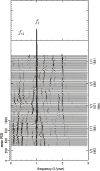Time series analysis of incidence data of influenza in Japan
- PMID: 21088372
- PMCID: PMC3899513
- DOI: 10.2188/jea.je20090162
Time series analysis of incidence data of influenza in Japan
Abstract
Background: Much effort has been expended on interpreting the mechanism of influenza epidemics, so as to better predict them. In addition to the obvious annual cycle of influenza epidemics, longer-term incidence patterns are present. These so-called interepidemic periods have long been a focus of epidemiology. However, there has been less investigation of the interepidemic period of influenza epidemics. In the present study, we used spectral analysis of influenza morbidity records to indentify the interepidemic period of influenza epidemics in Japan.
Methods: We used time series data of the monthly incidence of influenza in Japan from January 1948 through December 1998. To evaluate the incidence data, we conducted maximum entropy method (MEM) spectral analysis, which is useful in investigating the periodicities of shorter time series, such as that of the incidence data used in the present study. We also conducted a segment time series analysis and obtained a 3-dimensional spectral array.
Results: Based on the results of power spectral density (PSD) obtained from MEM spectral analysis, we identified 3 periodic modes as the interepidemic periods of the incidence data. Segment time series analysis revealed that the amount of amplitude of the interepidemic periods increased during the occurrence of influenza pandemics and decreased when vaccine programs were introduced.
Conclusions: The findings suggest that the temporal behavior of the interepidemic periods of influenza epidemics is correlated with the magnitude of cross-reactive immune responses.
Figures




Similar articles
-
MEM spectral analysis for predicting influenza epidemics in Japan.Environ Health Prev Med. 2012 Mar;17(2):98-108. doi: 10.1007/s12199-011-0223-0. Epub 2011 Jun 7. Environ Health Prev Med. 2012. PMID: 21647571 Free PMC article.
-
Effect of climatic conditions on epidemic patterns of influenza in Okinawa, Japan, during the pandemic of 2009: surveillance of rapid antigen test results.Jpn J Infect Dis. 2012 Jul;65(4):295-300. doi: 10.7883/yoken.65.295. Jpn J Infect Dis. 2012. PMID: 22814150
-
[Comparative characteristics of influenza type A infection in adults and children during epidemics and interepidemic periods].Vopr Virusol. 1981 Mar-Apr;(2):180-5. Vopr Virusol. 1981. PMID: 7269525 Russian.
-
An Epidemiological Analysis of Summer Influenza Epidemics in Okinawa.Intern Med. 2016;55(24):3579-3584. doi: 10.2169/internalmedicine.55.7107. Epub 2016 Dec 15. Intern Med. 2016. PMID: 27980256 Free PMC article. Review.
-
Global patterns in monthly activity of influenza virus, respiratory syncytial virus, parainfluenza virus, and metapneumovirus: a systematic analysis.Lancet Glob Health. 2019 Aug;7(8):e1031-e1045. doi: 10.1016/S2214-109X(19)30264-5. Lancet Glob Health. 2019. PMID: 31303294
Cited by
-
Time series analysis and short-term forecasting of monkeypox outbreak trends in the 10 major affected countries.BMC Infect Dis. 2024 Jan 2;24(1):16. doi: 10.1186/s12879-023-08879-5. BMC Infect Dis. 2024. PMID: 38166831 Free PMC article.
-
How do El Niño Southern Oscillation (ENSO) and local meteorological factors affect the incidence of seasonal influenza in New York state.Hyg Environ Health Adv. 2022 Dec;4:100040. doi: 10.1016/j.heha.2022.100040. Epub 2022 Nov 28. Hyg Environ Health Adv. 2022. PMID: 36777308 Free PMC article.
-
Forecasting peaks of seasonal influenza epidemics.PLoS Curr. 2013 Jun 21;5:ecurrents.outbreaks.bb1e879a23137022ea79a8c508b030bc. doi: 10.1371/currents.outbreaks.bb1e879a23137022ea79a8c508b030bc. PLoS Curr. 2013. PMID: 23873050 Free PMC article.
-
MEM spectral analysis for predicting influenza epidemics in Japan.Environ Health Prev Med. 2012 Mar;17(2):98-108. doi: 10.1007/s12199-011-0223-0. Epub 2011 Jun 7. Environ Health Prev Med. 2012. PMID: 21647571 Free PMC article.
-
Forecasting daily Covid-19 cases in the world with a hybrid ARIMA and neural network model.Appl Soft Comput. 2022 Sep;126:109315. doi: 10.1016/j.asoc.2022.109315. Epub 2022 Jul 15. Appl Soft Comput. 2022. PMID: 35854916 Free PMC article.
References
-
- Glezen WP, Couch RB. Influenza viruses. In: Evans AL, Kaslow RA, editors. Viral infections of humans: epidemiology and control. 4th ed. New York: Plenum Medical Book Company; 1997. p. 473–505.
-
- Brachman PB. Surveillance. In: Evans AL, Brachman PS, editors. Bacterial infections of humans: epidemiology and control. 2nd ed. New York: Plenum Medical Book Company; 1991. p. 49–61.
-
- MacMahon B, Pugh TF. Epidemiology: principles and method. Boston: Brown Company; 1970. p. 157–73.

